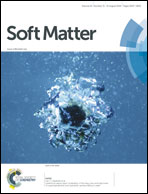Rationally designed anion-responsive-organogels: sensing F−via reversible color changes in gel–gel states with specific selectivity†
Abstract
Through the rational introduction of the multi self-assembly driving forces and F− sensing sites into a gelator molecule, low-molecular-weight organogelators L1 and L2 were designed and synthesized. L1 and L2 showed excellent gelation ability in DMF and DMSO. They could form stable organogels (OGL1 and OGL2) in DMF and DMSO with very low critical gelation concentrations. OGL1 and OGL2 could act as anion-responsive organogels (AROGs). Unlike most of the reported AROGs showing gel–sol phase transition according to the anions' stimulation, OGL1 could colorimetrically sense F− under gel–gel states. Upon addition of F−, OGL1 showed dramatic color changes, while the color could be recovered by adding H+. Moreover, OGL1 showed specific selectivity for F−, other common anions and cations could not lead to any similar response. What deserves to be mentioned is that the report on specific sensing of anions under gel–gel states is very scarce. The gel–gel state recognition can endow the organogel OGL1 with the merits of facile and efficient properties for rapid detection of F−. Therefore, OGL1 could act as a F− responsive smart material.


 Please wait while we load your content...
Please wait while we load your content...